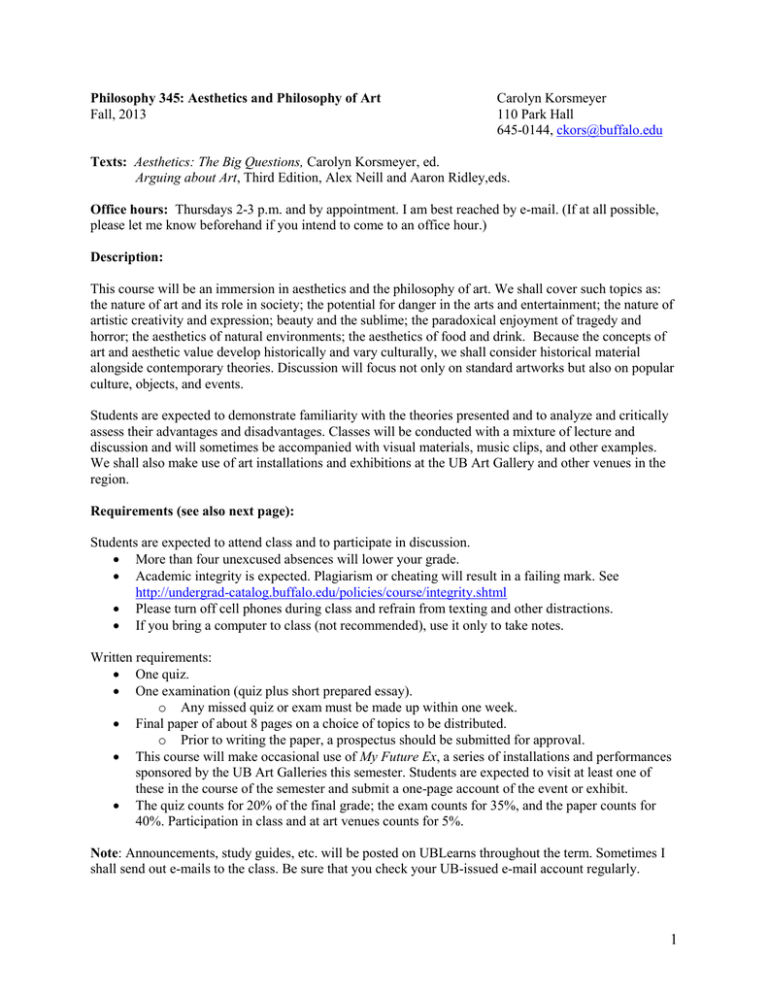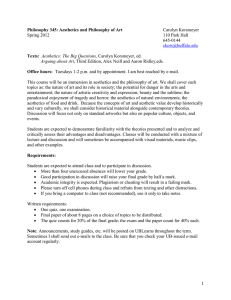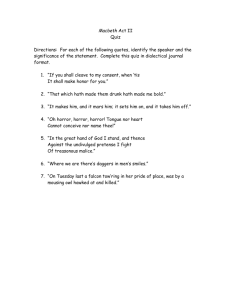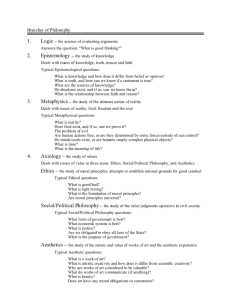345 syllabus
advertisement

Philosophy 345: Aesthetics and Philosophy of Art Fall, 2013 Carolyn Korsmeyer 110 Park Hall 645-0144, ckors@buffalo.edu Texts: Aesthetics: The Big Questions, Carolyn Korsmeyer, ed. Arguing about Art, Third Edition, Alex Neill and Aaron Ridley,eds. Office hours: Thursdays 2-3 p.m. and by appointment. I am best reached by e-mail. (If at all possible, please let me know beforehand if you intend to come to an office hour.) Description: This course will be an immersion in aesthetics and the philosophy of art. We shall cover such topics as: the nature of art and its role in society; the potential for danger in the arts and entertainment; the nature of artistic creativity and expression; beauty and the sublime; the paradoxical enjoyment of tragedy and horror; the aesthetics of natural environments; the aesthetics of food and drink. Because the concepts of art and aesthetic value develop historically and vary culturally, we shall consider historical material alongside contemporary theories. Discussion will focus not only on standard artworks but also on popular culture, objects, and events. Students are expected to demonstrate familiarity with the theories presented and to analyze and critically assess their advantages and disadvantages. Classes will be conducted with a mixture of lecture and discussion and will sometimes be accompanied with visual materials, music clips, and other examples. We shall also make use of art installations and exhibitions at the UB Art Gallery and other venues in the region. Requirements (see also next page): Students are expected to attend class and to participate in discussion. More than four unexcused absences will lower your grade. Academic integrity is expected. Plagiarism or cheating will result in a failing mark. See http://undergrad-catalog.buffalo.edu/policies/course/integrity.shtml Please turn off cell phones during class and refrain from texting and other distractions. If you bring a computer to class (not recommended), use it only to take notes. Written requirements: One quiz. One examination (quiz plus short prepared essay). o Any missed quiz or exam must be made up within one week. Final paper of about 8 pages on a choice of topics to be distributed. o Prior to writing the paper, a prospectus should be submitted for approval. This course will make occasional use of My Future Ex, a series of installations and performances sponsored by the UB Art Galleries this semester. Students are expected to visit at least one of these in the course of the semester and submit a one-page account of the event or exhibit. The quiz counts for 20% of the final grade; the exam counts for 35%, and the paper counts for 40%. Participation in class and at art venues counts for 5%. Note: Announcements, study guides, etc. will be posted on UBLearns throughout the term. Sometimes I shall send out e-mails to the class. Be sure that you check your UB-issued e-mail account regularly. 1 Assignment Quiz Part I of examination Learning Outcome Understanding the details of theories of art and aesthetics. Part II of examination Accurate expression of theoretical positions. Final paper and prospectus Independent research of scope adequate to topic; critical assessment of theoretical positions; writing skills. Participation in art installations and performances (see below). Independent learning in relation to contemporary art projects. Assessment Accuracy of answers to specific short-answer questions. Grade scale: 93-100 = A; 90-92 = A-; 87-89 = B+; 83-86 = B; 8082 = B-; 77-79 = C+; 73-76 = C; 70-72 = C-; 67-69 = D+; 63-66 = D; 60-62 = D-; below 60 = F. Short essay on a topic to be distributed in advance. Assessed for correctness of exposition and clarity and accuracy of presentation. Prospectus assessed for timeliness of submission; suggestions made on adequacy of topic. Paper assessed for care in research, expressive articulateness, and accuracy of writing (grammar, spelling, and so forth). One-page write up of an installation or performance. Assessed for content and expressive clarity. See previous page for further notes regarding grades and final marks. This course will make use of a set of exhibitions sponsored by the UB Art Gallery entitled My Future Ex: Site-specific Installations and Performances throughout the City of Buffalo, running from September 17November 23. The full schedule of these is not available at the time of this writing and will be posted later. See http://www.ubartgalleries.org/#?select=events. Students are also invited to visit the exhibit of paintings curated by UB Professor of Philosophy and Comparative Literature Jorge Gracia entitled Painting Borges: Art Interpreting Literature at the Anderson Gallery September 1-January 5. There will be a panel discussion of the exhibit on Friday, September 20, 3-5 pm in 120 Clemens Hall. See http://www.acsu.buffalo.edu/~gracia/borges/. For the University’s policy on Incomplete grades, see http://undergrad-catalog.buffalo.edu/policies/grading/explanation.shtml#incomplete For information on accessibility resources, see http://www.student-affairs.buffalo.edu/ods/ 2 Schedule of readings and assignments Week of: The Concept of Art Aug. 26 Introduction to course. Plato, from the Republic, in Aesthetics: the Big Questions (hereafter BQ) (Full text available at http://classics.mit.edu/Plato/republic.html. We will read portions of Books III, IV, and X.) Shiner, “Western and Nonwestern Concepts of Art,” in Arguing about Art (AA) Sept. 2 Anderson, from Calliope’s Sisters (BQ) Dutton, “But They Don’t Have Our Concept of Art,” (AA) Msosa Mwale, “Against Tradition” (BQ) [Classes canceled for Rosh Hashanah, Thursday, Sept. 5] Sept. 9 Danto, “The Artworld” (BQ) Suzuki, “Zen and the Art of Tea” (BQ) Sept. 16 Tilted Arc, transcript of hearing (AA) Hein, “What is Public art? Time, Place, and Meaning” (AA) Horowitz, “Public Art/Public Space” (AA) Kelly, “The Public Art Controversy: the Serra and Lin Cases” (AA) Danto, “The Vietnam Veteran’s Memorial” (BQ) Thursday, September 19, the class will meet at the UB Art Gallery. The Concept of the Aesthetic and the nature of “taste” Sept. 23 Hume, “Of the Standard of Taste” (BQ) Dewey, “The Live Creature,” (BQ) Stolnitz, “The Aesthetic Attitude” (BQ) Eaton, “Locating the Aesthetic” (BQ) Sept. 30 Telfer, “Food as Art” ( AA) Korsmeyer, “The Meaning of Taste and the Taste of Meaning” (AA) Bourdieu, from Distinction (BQ) Cohen, “High and Low Thinking about High and Low Art” (BQ) QUIZ THURSDAY, OCTOBER 3 (short answer) Creativity, genius, artistic production, and gender Oct. 7 Kant, from the Critique of Judgment (BQ) Battersby, from Gender and Genius (BQ) Parker and Pollock, “Crafty Women and the Hierarchy of the Arts” (BQ) Oct. 14 Nochlin, “Why Are There No Great Women Artists?” (BQ) Duncan, “The MOMA’s Hot Mama’s” (BQ) 3 Aesthetic value and the appreciation of nature Oct. 21 Carlson, “Aesthetic Appreciation and the Natural Environment” (AA) Carroll, “On Being Moved by Nature” (AA) Budd, “Models of Nature Appreciation (AA) Authenticity and Forgery Oct. 28 Lessing, “What is wrong with a Forgery?” (AA) Dutton, “Artistic Crimes” (AA) Davies, “Authenticity and Musical Performance” (AA) Young, “The Concept of Authentic Performance” (AA) EXAMINATION THURSDAY, OCTOBER 31 (short answers plus essay) Art, Emotional Arousal, and Moral Understanding Nov. 4 Tragedy: Pity and Fear Sophocles, Choral Ode (BQ) Aristotle, from the Poetics (BQ) Nietzsche, from The Birth of Tragedy (BQ) Nussbaum, “Form and Content, Philosophy and Literature” (BQ) Nov. 11 The Sublime: Terror and Awe Poe, “A Descent into the Maelstrom” (BQ) Burke, from A Philosophical Inquiry into the Sublime and Beautiful (BQ) Kant, from The Critique of Judgment (BQ) Nov. 18 Horror: Fear and Disgust Gaut, “The Paradox of Horror” (AA) Carroll, from The Philosophy of Horror (BQ) Carroll, “Why Horror?” (AA) Freeland, “Realist Horror” (BQ) Nov. 25 Neill, “Fiction and the Emotions” (AA) Kendall Walton, “Fearing Fictionally” (AA) [Wednesday-Friday – Thanksgiving Recess] Dec. 2 Norman, “Carnage and Glory, Legends and Lies” (BQ) Murdoch, “The Sovereignty of Good over Other Concepts” (BQ) PAPER DUE FRIDAY, DECEMBER 6, BY 2 PM. 4





